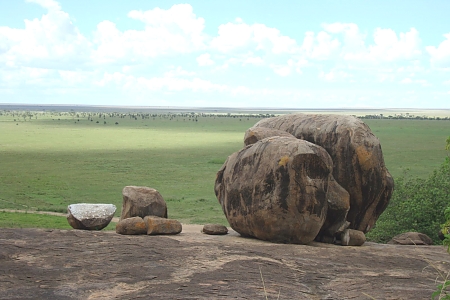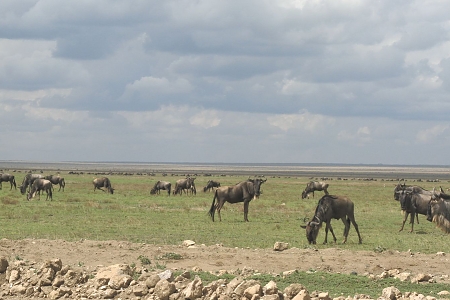Serengeti National Park, located 335 km from Arusha town, is one of the world's best-known wildlife sanctuaries. Spanning approximately 14,763 square kilometers, this extraordinary park features a diverse terrain, including grassy plains, savannah with acacias, wooded hills, and mountains. These varied landscapes create a stunning backdrop for an incredible concentration of wildlife, reaching its peak during the renowned wildebeest migration.
The Great Wildebeest Migration
The Serengeti-Mara ecosystem is home to around 2 million wildebeest, whose annual migration is one of the most awe-inspiring natural events. Covering an area of about 26,000 square miles, the migration sees these wildebeest, along with hundreds of thousands of zebras and gazelles, journey in search of grazing land. The best time to witness this breathtaking spectacle is from December to July, while the prime time to observe predators in action is from June to October.
A Haven for Wildlife
Often described as one of the world's last great wildlife refuges, the Serengeti supports the largest remaining concentration of plains game in Africa. This vast area, comparable in size to Northern Ireland, is home to an estimated three million large animals. Most of these animals participate in a seasonal migration, a phenomenon that has earned the Serengeti its Maasai name 'Siringet,' meaning endless plains.
The Seasonal Rhythms
The migration is primarily driven by the seasonal rains. The wet season starts in November and lasts until about May, with the herds typically moving out by the end of May. This continuous search for grass and water involves the consumption of over 4,000 tons of grass each day. The migration coincides with the breeding season, resulting in dramatic battles among the males.
As the dry season sets in, the herds drift out of the West, splitting into two groups: one moving north and the other northeast, heading towards the permanent waters of the northern rivers and the Mara. The drive to migrate is so powerful that many animals perish in the rivers, falling prey to crocodiles. Survivors gather in Kenya’s Maasai Mara National Reserve until the grazing there is depleted, prompting their return south along the eastern migration route. Before the main exodus, the sight of the massed herds, with the weak and crippled trailing behind, followed closely by vigilant predators, is truly spectacular.
Diverse Vegetation and Landscapes
The Serengeti's vegetation ranges from the short and long grass plains in the south to the acacia savannah in the center and the wooded grasslands around the Grumeti and Mara rivers. The western corridor features a region of wooded highlands and extensive plains stretching to the edge of Lake Victoria.
Wildlife Hotspots
One of the park’s most famous regions is the Seronera Valley, renowned for its high density of lions and leopards, which are often easily spotted. The adult male lions in the Serengeti are particularly notable for their distinctive black manes.
Plan Your Visit
A visit to Serengeti National Park offers an unparalleled wildlife experience. From witnessing the dramatic wildebeest migration to spotting the majestic big cats in the Seronera Valley, every moment in the Serengeti is filled with wonder and excitement. Whether you are a seasoned traveler or a first-time visitor, the Serengeti promises a journey into the heart of Africa’s wild beauty. Plan your adventure with Wonders of Creation Tours and Safaris, and immerse yourself in the magic of this legendary park.



_450_300shar-50brig-20_c1_c_t.jpg)

_450_300shar-50brig-20_c1_c_t.jpg)


